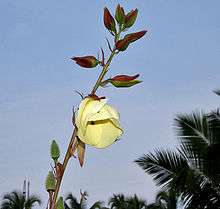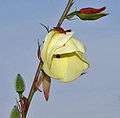Abelmoschus
| Abelmoschus | |
|---|---|
 | |
| Abelmoschus esculentus leaves, flower buds and young fruit | |
| Scientific classification | |
| Kingdom: | Plantae |
| Clade: | Angiosperms |
| Clade: | Eudicots |
| Clade: | Rosids |
| Order: | Malvales |
| Family: | Malvaceae |
| Subfamily: | Malvoideae |
| Tribe: | Hibisceae |
| Genus: | Abelmoschus Medik.[1] |
| Species | |
|
See text. | |
Abelmoschus is a genus of about fifteen species of flowering plants in the mallow family, Malvaceae, native to tropical Africa, Asia and northern Australia. It was formerly included within Hibiscus, but is now classified as a distinct genus.
The genus comprises annual and perennial herbaceous plants, growing to 2 m tall. The leaves are 10–40 cm long and broad, palmately lobed with 3-7 lobes, the lobes are very variable in depth, from barely lobed, to cut almost to the base of the leaf. The flowers are 4–8 cm diameter, with five white to yellow petals, often with a red or purple spot at the base of each petal. The fruit is a capsule, 5–20 cm long, containing numerous seeds.
Abelmoschus species are used as food plants by the larvae of some Lepidoptera species including Chionodes hibiscella which has been recorded on A. moschatus.
- Selected Species
- Abelmoschus caillei - (syn. Hibsicus manihot var. caillei). West African okra
- Abelmoschus esculentus - (syn. Hibiscus esculentus). Okra
- Abelmoschus manihot - (syn. Hibiscus manihot). Aibika
- Abelmoschus moschatus - (syn. Hibiscus abelmoschus). Musk Mallow
- Abelmoschus ficulneus - (syn. Hibiscus ficulneus). White Wild Musk Mallow
- Abelmoschus crinitus - (syb. Hibiscus crinitus)
Uses
Several species are edible, with both the young seed pods and the young leaves being eaten as a vegetable. The most important commercially-grown species is okra.
Abelmoschus manihot (aibika) furnishes cordage like jute, and Abelmoschus moschatus (musk mallow) is grown for musk seeds (musk ambrette, which causes photoallergy).
Gallery of different species
See also
References
| Wikimedia Commons has media related to Abelmoschus. |
| Wikispecies has information related to: Abelmoschus |
- ↑ "Abelmoschus". Germplasm Resources Information Network. United States Department of Agriculture. 2007-03-12. Retrieved 2009-02-20.
- Kundu BC, Biswas C. 1973. Anatomical characters for distinguishing the genera Abelmoschus and Hibiscus. Proc. Indian Sci. Congr. 60. (3): 295





_leaves_in_Kawal%2C_AP_W_IMG_2221.jpg)
_leaves_in_Kawal%2C_AP_W_IMG_2216.jpg)
_in_Kawal%2C_AP_W_IMG_2214.jpg)
_fruit_in_Kawal%2C_AP_W_IMG_2218.jpg)